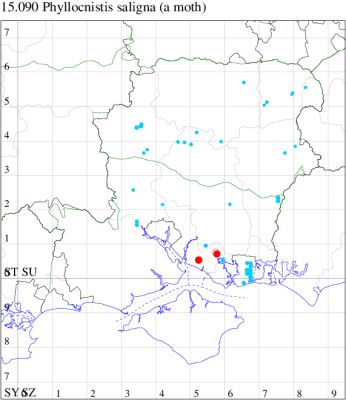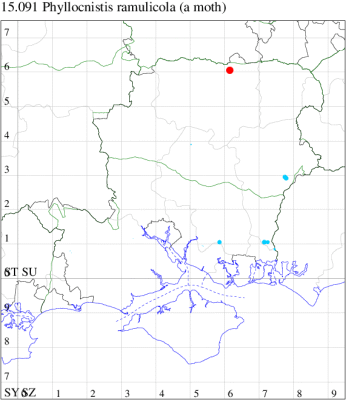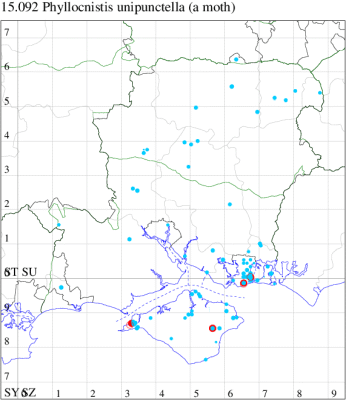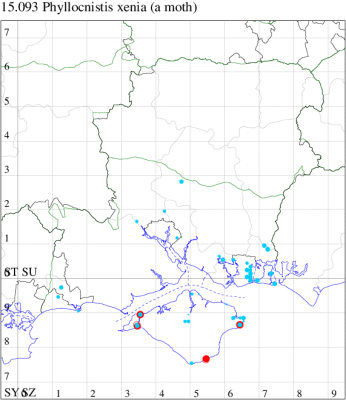2020 Annual Report for: Gracillariidae / Phyllocnistinae
For species seen in 2020 that had less than or equal to 100 records, full details are included; for more common species, the earliest, latest and highest count by vice-county are shown. The narrative for each species is taken from the main Hantsmoths website, and it is possible that some information on abundance and occurrence can get out of date, as it is impossible to keep up with all changes; however it should give a good introduction to each species. The tables in each species account summarise the previous status, and that for the current year.
For the maps, all records prior to 2020 are shown by a blue dot (the larger the dot, the more recent), with the current year's records shown in red. As previous records are superimposed on any report for 2020, new sites have greater emphasis (i.e. will show as 'more red').
In the species accounts, an asterisk next to a location indicates a new 10km square record; earliest ever dates are highlighted in orange, and latest ever in red. Initials in the species accounts refer to the recorders listed here. Please get in touch if you identify any omissions or errors, in particular if you have records that have yet to be submitted. Details of how to submit records can be found here.
15.090 [B&F: 0367] Phyllocnistis saligna (Zeller, 1839) - Local
Local in fens, marshes, river-banks and other damp areas throughout southern England. In Hampshire known only from a handful of sites, including Fleet, Greywell Moors, Southsea and Leckford, but perhaps under-recorded. Not recorded from the Isle of Wight to date. Wingspan 6-7 mm. More frequently recorded in the larval stage, when the mines are fairly easy to find where they are present; the imago can be separated from P. ramulicola only by dissection of the genitalia. Larva mines leaves of Purple Willow and Crack Willow.
Records prior to 2020
| Vice County | #Records | #Individuals | First Record | Last Record |
|---|---|---|---|---|
| 11 | 38 | 8 | 1900 | 2019 |
| 12 | 38 | 12 | 1983 | 2018 |
2020 records
| Vice County | #Records | #Individuals | Max Quantity |
|---|---|---|---|
| 11 | 10 | 11 | 10 |
| 12 | 2 | 1 | 1 |

Records by year
Records by week (adult)
Records by week (larval)
Record Details
VC11: Titchfield Common, vacated mine, present, on willow, 13 Dec (DWal); Fareham, vacated mine, 10, sub-epidermal mines in twigs of Salix fragilis, 28 Nov (KJW det. RJD); Baffins, Portsmouth, mine, present, a few, Salix fragilis, 24 Nov; Portsmouth, mine, present, very many on Salix alba and a few on S. fragilis, 23 Oct; mine, present, a few, Salix alba, S. fragilis, 24 Nov; Milton Common, mine, present, many, Salix fragilis, S. purpurea, 19 Oct (JRL, IRT);
VC12: Anna Valley, Andover, one, not dissected, 30 Jul (TJN)
15.091 [B&F: 0367a] Phyllocnistis ramulicola Langmaid & Corley, 2007 - Nationally Scarce A
Nationally scarce (Na) in damp woodland in southern England. First discovered in 2006 as new to science in Havant Thicket, Hampshire, subsequently found more widely in Hampshire and adjacent counties. In 2007, found to be widespread, and hence likely to have been a long-term, previously undiscovered resident. Not recorded from the Isle of Wight to date. Wingspan 6-7 mm. More frequently recorded in the larval stage, when the mines are fairly easy to find where they are present; the imago can be separated from P. saligna only by dissection of the genitalia. Larva mines stems of Grey Willow, Goat Willow and Eared Willow. Mine very similar to P. saligna, which mines only Purple Willow and Crack Willow.
Records prior to 2020
| Vice County | #Records | #Individuals | First Record | Last Record |
|---|---|---|---|---|
| 11 | 60 | 20 | 2006 | 2019 |
| 12 | 7 | 12 | 2007 | 2019 |
2020 records
| Vice County | #Records | #Individuals | Max Quantity |
|---|---|---|---|
| 12 | 1 | 0 | 0 |

Records by year
Records by week (adult)
Records by week (larval)
Record Details
VC12: Pamber Forest*, mine, present, in young grey willow pollard re-growth, 27 Oct (GJD)
15.092 [B&F: 0368] Phyllocnistis unipunctella (Stephens, 1834) - Common
Common in woodland, areas with scattered trees and gardens throughout much of southern England and southern Wales, with records north to Cheshire. Probably under-recorded in Hampshire and on the Isle of Wight, where the extent of known records correlate with those areas in which the recording effort is concentrated. Wingspan 7-8 mm. Comes readily to light, the second generation often overwinters in thatch or hayricks (MBGBI Vol 2). Larva mines leaves of Black Poplar and Lombardy Poplar.
Records prior to 2020
| Vice County | #Records | #Individuals | First Record | Last Record |
|---|---|---|---|---|
| 10 | 42 | 14 | 1975 | 2018 |
| 11 | 557 | 905 | 1980 | 2019 |
| 12 | 28 | 12 | 1982 | 2019 |
2020 records
| Vice County | #Records | #Individuals | Max Quantity |
|---|---|---|---|
| 10 | 2 | 2 | 1 |
| 11 | 20 | 25 | 3 |
| 12 | 1 | 1 | 1 |

Records by year
Records by week (adult)
Records by week (larval)
Record Details
VC10: Totland, one, 20 Sep (RTe); Newchurch, mine, one, on leaf of Populus nigras, 17 Sep (PBa);
VC11: Portsmouth, one, 18 Jul; one, 01 Aug; one, 02 Aug; two, 03 Aug; one, 07 Aug; one, 09 Aug; one, 20 Aug; one, 23 Aug; three, 26 Aug (IRT); Southsea, two, 29 May; one, 02 Jun (JRL);
VC12: Cholderton*, one, 08 Aug (TJN, HE)
15.093 [B&F: 0369] Phyllocnistis xenia Hering, 1936 - Nationally Scarce B
Nationally scarce (Nb) along river banks and in damp woodland. First discovered in eastern Kent in 1974, subsequently rapidly spreading throughout south-eastern England. First recorded on the Isle of Wight in 2002, and in Hampshire in the following year; mines are locally common on White and Grey Poplar in the Portsmouth area and on Hayling Island. Wingspan 6-7 mm.
Records prior to 2020
| Vice County | #Records | #Individuals | First Record | Last Record |
|---|---|---|---|---|
| 10 | 29 | 27 | 2002 | 2019 |
| 11 | 85 | 18 | 2000 | 2019 |
2020 records
| Vice County | #Records | #Individuals | Max Quantity |
|---|---|---|---|
| 10 | 4 | 1 | 1 |
| 11 | 3 | 0 | 0 |

Records by year
Records by week (adult)
Records by week (larval)
Record Details
VC10: Afton Marsh, one, field observation, 11 Oct (SDa); Yarmouth, mine, present, several mines on leaves of Populus alba, 25 Sep; Ventnor Botanic Garden, mine, present, snail' mines on upper surface of Populus alba leaves, 26 Sep; Bembridge, mine, present, several upper surface 'snail' mines on leaves of Populus alba, 01 Oct (PBa)
15.0931 [B&F: 0366b] Phyllocnistis citrella Stainton, 1856 - Adventive
A miner of the leaves and fruit of Citrus species. First described from India, it has become widespread globally wherever Citrus is grown commercially, spread by the export of the hostplant: in continental Europe recorded from the Azores, Balearic Isles Canary Isles, and throughout the Mediterranean region. In Britain, the first written account was of mines found and adults reared from Citrus from a garden centre in Burford, Oxfordshire in October 2012 by Robert Homan and recounted in Entomologist's Rec. J. Var (124) 2012: 279-281, which highlights the multiple incidents of interceptions at British ports and airports by the Plant Health and Seeds Inspectorate, and prior findings of mines in garden centres and supermarkets between 2004 and 2008. First identified in Hampshire from a shop-bought Citrus in 2014, and new to the Isle of Wight in 2020.
Records prior to 2020
| Vice County | #Records | #Individuals | First Record | Last Record |
|---|---|---|---|---|
| 11 | 1 | 1 | 2014 | 2014 |
2020 records
| Vice County | #Records | #Individuals | Max Quantity |
|---|---|---|---|
| 10 | 1 | 2 | 2 |
Records by year
Records by week (adult)
Records by week (larval)
Record Details
VC10: New Vice-county Record: Freshwater*, vacated mine, two, two 'silvery' mines on leaves of a potted Citrus Lemon, 22 Sep (PBa)